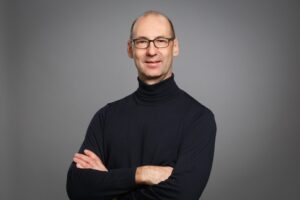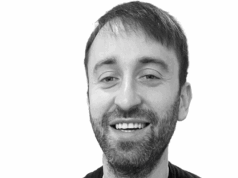 Despite his initial intention to become a transplant surgeon, Markus Steinbauer (Krankenhaus Barmherzige Brüder, Regensburg, Germany) recalls how the rise of endovascular techniques, and the possibilities for procedural advancement they posed in vascular surgery, led him to change career course. Steinbauer, now head of the Department of Surgery at the Krankenhaus Barmherzige Brüder and president of the German Society of Vascular Surgery (DGG), considers how the field of vascular surgery has changed over the course of his career, anticipates future challenges vascular surgeons might face—including those associated with an ageing population—and expresses his interest in seeing further developments in artificial intelligence and imaging to improve endovascular treatment modalities and reduce radiation exposure.
Despite his initial intention to become a transplant surgeon, Markus Steinbauer (Krankenhaus Barmherzige Brüder, Regensburg, Germany) recalls how the rise of endovascular techniques, and the possibilities for procedural advancement they posed in vascular surgery, led him to change career course. Steinbauer, now head of the Department of Surgery at the Krankenhaus Barmherzige Brüder and president of the German Society of Vascular Surgery (DGG), considers how the field of vascular surgery has changed over the course of his career, anticipates future challenges vascular surgeons might face—including those associated with an ageing population—and expresses his interest in seeing further developments in artificial intelligence and imaging to improve endovascular treatment modalities and reduce radiation exposure.
Why did you decide to pursue a career in medicine and why, in particular, did you choose to specialise in vascular surgery?
I was attracted to medicine as a career by its diversity as a scientific discipline and the opportunities to interact and communicate with patients and colleagues in a trustworthy and special relationship.
Originally, I aimed to become a transplant surgeon. However, during my training in general/transplant surgery at the end of the last millennium, I was deeply impressed by and attracted to the rapid and unbelievable development of endovascular surgery and the tremendous potential advances it posed in the future of vascular surgery. For this reason, I decided to specialise in vascular surgery and I have never regretted this decision, not even during complex and long-lasting nocturnal procedures.
Who were your career mentors and what was the best advice that they gave you?
My first scientific mentor was Konrad Messmer, who is one of the leading scientists in microcirulatory research. He taught me that science is pivotal for the further development of medical disciplines, and also that precise and structured planning, in combination with intense collaboration, are essential elements for the successful realisation of a project.
Piotr Kasprzak was another mentor of mine. He shared his devotion and fascination for vascular and endovascular surgery and commitment to constant technical development according to the motto ‘standstill is regression’.
What has been the most important development in vascular surgery during your career so far?
The most important development has been the endovascular ‘revolution’, combining new concepts of imaging with new endovascular techniques and devices. This has allowed us to treat complex lesions in vulnerable patients. To learn and perform the first aortic interventions in abdominal aortic aneurysm (AAA) patients with basic C-arms and to apply the development of these techniques to complex procedures from the aortic arch to the iliacs has been one of the most impressive evolutions for me in my career in vascular surgery.
Another important development has been the implementation of various techniques and devices in the endovascular treatment of peripheral occlusive disease (POD). These changes and developments were only made possible by the implementation of the Hybrid operating room (OR) concept and the dramatic improvement of imaging in our specialty.
What has been the biggest disappointment?
As a young scientist working on microcirculation and angiogenesis, I placed great hope in the use of angiogenetic factors in no-option POD patients. Inducing a relevant collateralisation by using angiogenetic factors by injection or gene therapy would have been a striking therapeutic concept. Unfortunately, the promising preclinical results were not proven in relevant clinical trials.

How do you anticipate the field might change in the next decade, and what development would you most like to see realised?
As is the case in oncology, I hope that an individual diagnosis of specific molecular markers and targets in the vessel wall may help to personalise a specific prophylaxis and treatment of atherosclerosis.
Furthermore, I would like to see further development in artificial intelligence and imaging, for example by mixed virtual reality to improve endovascular treatment modalities and to reduce radiation. The technical prerequisites are already available; we now have to adapt these techniques and use them for the benefit of our patients.
What are the biggest challenges currently facing vascular surgery?
The biggest challenges facing vascular surgery are population ageing and, perhaps more importantly, the dramatic negative changes in nutrition and exercise/ sports behaviour in western societies. To recruit and educate/train young vascular surgeons to handle the expected tremendous workload of vascular patients will be a demanding but valuable challenge.
What are your current areas of research?
At present I am focused on four main areas of research. These are vascular graft infections, open surgery in chronic limb-threatening ischaemia (CLTI) and POD, imaging, and endovascular aortic treatment.
What do you think has been the most important paper published this year?
The paper with highest relevance for our clinical work in the future might be ‘Long-term cardiovascular outcomes of COVID-19’ by Yan Xie et al. This was published in February in Nature Medicine. In the paper, the authors describe an increase in the long-term risk and burden of cardiovascular diseases in COVID-19 patients. We have to elucidate the underlying mechanisms for these late vascular complications and find new solutions for prevention.
However, I think the paper that interested me the most this year was was ‘Neuroimmune cardiovascular interfaces control atherosclerosis,’ by Sarajo Mohanta et al, published this April in Nature. The authors describe a new mechanism of the development and progression of atherosclerosis—a direct interaction of the peripheral nervous system with diseased arteries by neuroimmune cardiovascular interfaces (NICIs). This might be highly relevant for the POD and diabetic foot patients in the future and at might give us the opportunity to develop therapeutic concepts including new surgical approaches.
What have been the highlights of your German Society of Vascular Surgery presidency?
My personal highlight was the organisation of the very successful and happy annual meeting (Jahrestagung) of the German Society of Vascular Surgery in October 2021 under COVID-19 conditions—the first hybrid Jahrestagung of the DGG. The revival of an onsite congress with cordial meetings and discussions with friends was the best event of my presidency. Furthermore, I am looking forward to the Dreiländertagung 2022 with our Austrian and Swiss friends in Vienna, Austria. Finally, I deeply enjoyed the multifaceted and trustworthy conversations/meetings with our members and colleagues and the tremendous input and devotion they gave to the development of our society.
What have been your most memorable cases?
A very memorable case was my first standalone surgical handling of an aortoenteric fistula in a haemodynamically unstable patient with graft infection as a young vascular surgeon. I learned that an uncompromising surgery and therapeutic endurance are the key factors for the control of these disastrous complications in vascular surgery.
Later on, as a newly elected head of the Department of Vascular Surgery at the Krankenhaus Barmherzige Brüder, the successful treatment of a ruptured thoracoabdominal aortic aneurysm (TAAA) in a young female patient with Marfan syndrome with open surgery gave my colleagues and me the confidence that our team and infrastructure were ready for further challenges.
What advice would you give to someone looking to start a career in medicine?
I have four pieces of advice for anyone looking to pursue a medical career. First of all, medicine/surgery is a dedication and not a job. Secondly, it is imperative that you serve the patient and not the hospital manager. I also advise the younger generation to choose vascular surgery as their specialty, as I strongly believe it is the best of all specialties. And, finally, keep calm and carry on!
What are your hobbies and interests outside of medicine?
One of my main hobbies is golf as, like vascular surgery, it teaches you humility and modesty. Another is skiing—both downhill and cross country skating— and I am the former coach for ski instructors of the German Ski Association. My interests are history, wine, and travelling with my family and friends.













